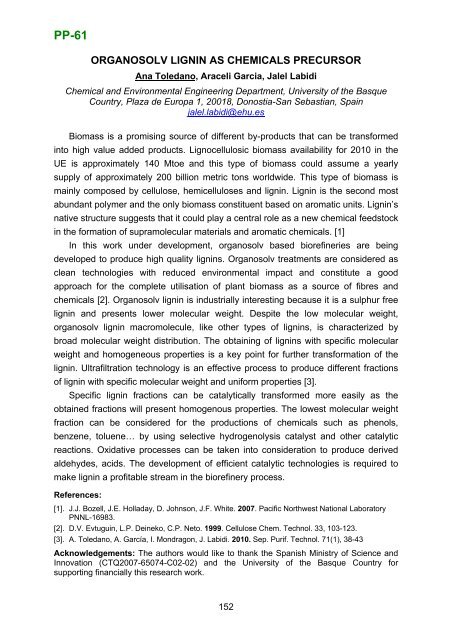Boreskov Institute of Catalysis SB RAS, Novosibirsk, Russia
Boreskov Institute of Catalysis SB RAS, Novosibirsk, Russia
Boreskov Institute of Catalysis SB RAS, Novosibirsk, Russia
- No tags were found...
Create successful ePaper yourself
Turn your PDF publications into a flip-book with our unique Google optimized e-Paper software.
PP-61ORGANOSOLV LIGNIN AS CHEMICALS PRECURSORAna Toledano, Araceli Garcia, Jalel LabidiChemical and Environmental Engineering Department, University <strong>of</strong> the BasqueCountry, Plaza de Europa 1, 20018, Donostia-San Sebastian, Spainjalel.labidi@ehu.esBiomass is a promising source <strong>of</strong> different by-products that can be transformedinto high value added products. Lignocellulosic biomass availability for 2010 in theUE is approximately 140 Mtoe and this type <strong>of</strong> biomass could assume a yearlysupply <strong>of</strong> approximately 200 billion metric tons worldwide. This type <strong>of</strong> biomass ismainly composed by cellulose, hemicelluloses and lignin. Lignin is the second mostabundant polymer and the only biomass constituent based on aromatic units. Lignin’snative structure suggests that it could play a central role as a new chemical feedstockin the formation <strong>of</strong> supramolecular materials and aromatic chemicals. [1]In this work under development, organosolv based biorefineries are beingdeveloped to produce high quality lignins. Organosolv treatments are considered asclean technologies with reduced environmental impact and constitute a goodapproach for the complete utilisation <strong>of</strong> plant biomass as a source <strong>of</strong> fibres andchemicals [2]. Organosolv lignin is industrially interesting because it is a sulphur freelignin and presents lower molecular weight. Despite the low molecular weight,organosolv lignin macromolecule, like other types <strong>of</strong> lignins, is characterized bybroad molecular weight distribution. The obtaining <strong>of</strong> lignins with specific molecularweight and homogeneous properties is a key point for further transformation <strong>of</strong> thelignin. Ultrafiltration technology is an effective process to produce different fractions<strong>of</strong> lignin with specific molecular weight and uniform properties [3].Specific lignin fractions can be catalytically transformed more easily as theobtained fractions will present homogenous properties. The lowest molecular weightfraction can be considered for the productions <strong>of</strong> chemicals such as phenols,benzene, toluene… by using selective hydrogenolysis catalyst and other catalyticreactions. Oxidative processes can be taken into consideration to produce derivedaldehydes, acids. The development <strong>of</strong> efficient catalytic technologies is required tomake lignin a pr<strong>of</strong>itable stream in the biorefinery process.References:[1]. J.J. Bozell, J.E. Holladay, D. Johnson, J.F. White. 2007. Pacific Northwest National LaboratoryPNNL-16983.[2]. D.V. Evtuguin, L.P. Deineko, C.P. Neto. 1999. Cellulose Chem. Technol. 33, 103-123.[3]. A. Toledano, A. García, I. Mondragon, J. Labidi. 2010. Sep. Purif. Technol. 71(1), 38-43Acknowledgements: The authors would like to thank the Spanish Ministry <strong>of</strong> Science andInnovation (CTQ2007-65074-C02-02) and the University <strong>of</strong> the Basque Country forsupporting financially this research work.152
















